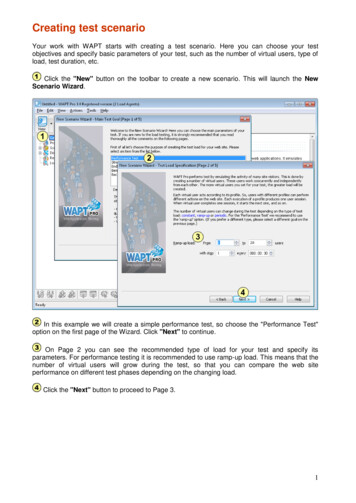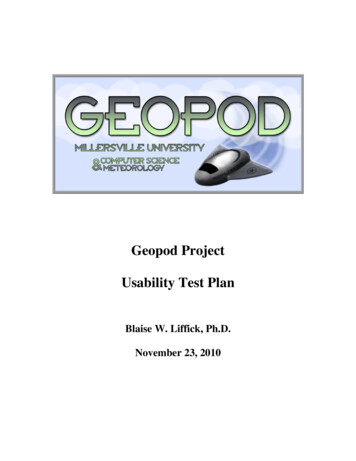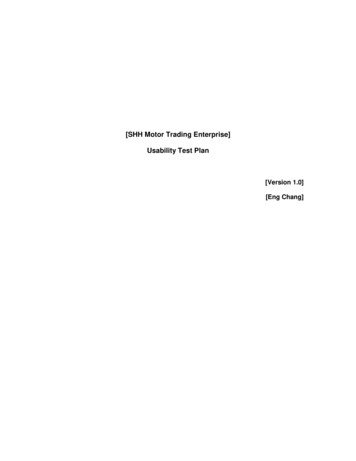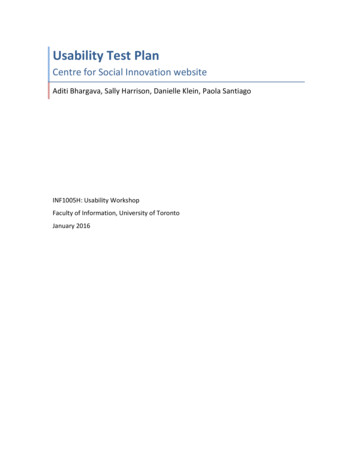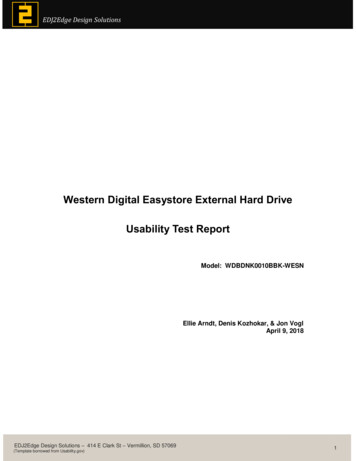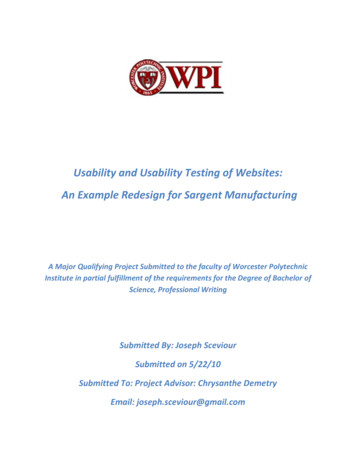
Transcription
Usability and Usability Testing of Websites:An Example Redesign for Sargent ManufacturingA Major Qualifying Project Submitted to the faculty of Worcester PolytechnicInstitute in partial fulfillment of the requirements for the Degree of Bachelor ofScience, Professional WritingSubmitted By: Joseph SceviourSubmitted on 5/22/10Submitted To: Project Advisor: Chrysanthe DemetryEmail: joseph.sceviour@gmail.com
ContentsTable of Figures . 4Abstract . 5Introduction . 6Background . 8Perspectives on Usability . 8Usability Engineering . 9Web Interfaces . 10Cultural Usability . 11Discount Usability Engineering . 12Heuristic Evaluation . 14Scenarios . 14User and Task Observation . 14Simplified Thinking Aloud . 15Between Subject vs. Within Subject Testing. 15A Case Study: The Sargent Manufacturing Website . 16Methodology. 20Identifying Different Users. 21Recruiting Testers . 21Employing the Discount Usability Testing Approach . 22Initial Heuristic Evaluation . 22User and Task Observation . 22Simplified Thinking Aloud . 23Scenarios . 23Heuristic Evaluation of Redesign . 24User and Task Observation of Redesign . 24Compare, Repeat as Necessary. 24Usability Problems with the Initial Website. 25Redesign of the Access Control Section of the Sargent Manufacturing Website . 31Reflections on Usability Testing . 43Heuristics. 43Scenarios . 432 Page
User Task Observation . 43Simplified Thinking Aloud . 44Cultural Usability Testing . 44Works Cited . 46Appendix 1 . 47Testing Introduction Form . 47Testing Situation # 1 Background . 48Testing Situation # 1 Metrics . 48Testing Situation # 2 Background . 49Testing Situation # 2 Metrics . 49Testing Situation # 3 Background . 50Testing Situation # 3 Metrics . 50Post-Testing Interview Questions . 513 Page
Table of FiguresFigure 1 Circuit of Culture (Melles, 2008) . 12Figure 2 Nielsen, "Why You Only Need to Test with 5 Users" . 13Figure 3 Sargent Manufacturing's Homepage www.sargentlock.com . 17Figure 4 Methodology Flowchart . 20Figure 5 Sargent Main Page with Jargon Highlighted . 25Figure 6 Poor Image Recognition on Current Sargent Site . 28Figure 7 No Common Information Section . 29Figure 8 No Common Information Section (continued) . 29Figure 9 Titles Looking Like Links . 30Figure 10 Icon Users Cannot Click . 30Figure 11 Old Access Control Page . 31Figure 12 New Access Control Page . 32Figure 13 Product Comparison . 34Figure 14 Product Line Sub-Page . 36Figure 15 Hover-Over Text . 38Figure 16 Product Line and Hardware Combination Page . 38Figure 17 Levers, Finishes, and Options . 40Figure 18 Product Identifier (Top) . 41Figure 19 Product Identifier (Bottom) . 42Figure 20 Technical Support Contact Page . 424 Page
AbstractThis project explores website usability and usability testing from engineering and culturalperspectives. Customers of Sargent Manufacturing reported significant difficulty using the company'swebsite. Analyzing the website from the perspective of different users, I investigated the site's usabilityusing heuristic and user-testing methods. After problems were identified, I created a redesigned site,which I then similarly tested to evaluate improvement.5 Page
IntroductionA user interface (UI) is the intersection of product and user. The coin slot and selection buttonson a vending machine or complex, the slew of buttons/commands in a computer application, thesteering wheel, gas pedal, brake pedal, and diagnostic lights on a car are all examples of user interfaces.That said, the term user interface is often used in relation to a computer interface. In this context, a userinterface is defined as, “The aspects of a computer system or program which can be seen (or heard orotherwise perceived) by the human user, and the commands and mechanisms the user uses to controlits operation and input data.” This project will focus on computer interfaces, specifically those ofwebsites. (Computing, 2009)Jakob Nielsen, perhaps the most famous usability expert, asserts that usability consists of fivecomponents: learnability, efficiency, memorability, minimization of errors, and satisfaction. (Nielsen,Usability Engineering, 1993) The ideal website would be immediately clear to new users, provide themwith the information they need immediately, easy to use even after long breaks away from the site,error-free, and provide a pleasant experience for the user. Unfortunately, few (if any) interfaces areperfect. Websites are often poorly laid-out, making navigation counter-intuitive. Applications often havepoorly labeled buttons or unclear prompts. New users often get confused by unclear layout, andreturning users often get frustrated by awkward or cumbersome ways of entering data. To preventthese problems, interfaces need to be designed for usability. “Usability is the degree to which people(users) can perform a set of required tasks. It is the product of several, sometimes conflicting designgoals.” (Brinck, Gergle, & Wood, 2002)To measure and improve usability, usability studies are often done. A usability study is animportant tool for evaluating a UI in which the effectiveness of the UI is judged. Based on the results,changes can be made to improve the interface. Usability studies often involve observing users trying toperform certain tasks, grading their performance, and having them talk about their thoughts eitherwhile using it or after. Usability studies can even involve a designer simply looking at the UI heuristically,checking the interface against common design rules or guidelines. These usability test methods canbecome expensive or cumbersome if done with large numbers of test users or usability testers.Therefore, especially in business, designing and implementing useful and cost-effective usability studiesis a necessary challenge. Nielsen has created a process for “discount usability testing.” It’s designed tobe a practical, cost efficient way to improve a user interface. Nielsen describes its practical goals he triesto “ focus in achieving ‘the good’ with respect to having some usability engineering work performed,even though the methods needed to achieve this result may not always be the absolutely “best” methodand will not necessarily give perfect results.” (Nielsen, Usability Engineering, 1993)In addition to testing an interface to find problems, a designer can improve a user interface byunderstanding the user. The user’s needs, knowledge, and goals all play an important part indetermining the best user interface. Complicating this, designers often do not know their users as wellas they would hope. Designers must make educated guesses in many cases about who is using theirproduct and how. User interfaces, especially web sites have a very diverse audience. Oftentimes inusability testing, usability heuristics for websites are sometimes based around catering to the general6 Page
public and testing treats test users as interchangeable. How
22.05.2010 · These usability test methods can become expensive or cumbersome if done with large numbers of test users or usability testers. Therefore, especially in business, designing and implementing useful and cost-effective usability studies is a necessary challenge. Nielsen has created a process for discount usability testing. Its designed to be a practical, cost efficient way to improve a user .File Size: 1MBPage Count: 51






